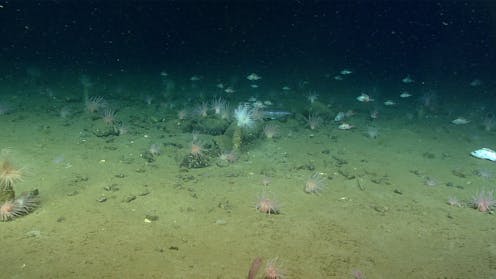
Protecting and effectively managing oceans and seabeds are crucial in the fight against climate change.
Oceans have absorbed more than 90 per cent of the excess heat from global warming and at least 25 per cent of global carbon dioxide (CO2) emissions. They also store vast amounts of carbon, locking it away from the atmosphere for hundreds to even thousands of years.
Coastal habitats such as mangroves, seagrass beds, saltmarshes and kelp forests have gained significant attention as natural climate solutions. In comparison, the sediments that line the seafloor have been generally ignored, even though they have been estimated to hold carbon stores considerably larger than that of trees and soils on land. A major contributing factor has been the lack of reliable, high-resolution maps of the seabed’s carbon store.
We are part of a group of scientists who set out to address that problem and our recent study details the creation of the first high-resolution maps of carbon in Canada’s seabed sediments.
These maps provide the first steps towards including climate change considerations in Canada’s seabed conservation.
Nature as a buffer
The Earth’s climate has already changed at an unprecedented scale and in the next five years, the world’s human population will have likely overshot the level of emissions that would limit global warming to 1.5 C.
The most significant action to prevent the worst effects of climate breakdown is to considerably reduce the burning of fossil fuels. But, due to the scale of the problem, every tool will be necessary.
Natural ecosystems act as a major buffer against climate change. Of all the carbon dioxide pumped into our atmosphere, around 60 per cent is absorbed by our lands and oceans. Damage to these ecosystems from human activities is, however, limiting their effectiveness, with 10 to 20 per cent of global greenhouse gas emissions originating from habitat degradation.
Forests and wetlands are often targeted for protection and restoration to help in the fight against climate change because they hold large amounts of carbon within their trees and soils. The important role that seabed sediments play in the ocean’s carbon cycle has been recognized for many years, but their ability to exacerbate or mitigate human caused climate change has only more recently been considered.

Mapping seabed carbon
One of the first steps towards incorporating climate change mitigation in seabed management is to quantify and map this major carbon store.
In our new study, we compiled the best available data on the composition of seabed sediments across Canada and combined this with a wide range of environmental data within a machine learning predictive mapping process to create the first national map of organic carbon stocks in seabed sediments.
The resulting high resolution seabed carbon map covers 4.5 million square kilometres, which is nearly 80 per cent of Canada’s total marine area or 90 per cent of the seafloor area above 2,500 metres.
In total, the amount of carbon estimated to exist within the top 30 centimetres of seabed sediments across Canada is 10.9 billion tonnes. This is equivalent to approximately 100 times that of all Canadian seagrass beds and saltmarshes combined, and around 60 per cent of the carbon contained in the trees of all the forests in Canada.
Canada’s carbon-rich seafloor
There is considerable variation in the amount of carbon stored in different parts of Canada’s seabed. On the west coast in British Columbia, the muddy sediments at the bottom of fjords and inlets were estimated to contain particularly high levels of carbon, along with parts of the enclosed Salish Sea. This was contrasted by very low carbon in shallower areas offshore, where strong waves and currents frequently stir up the sediment leaving little carbon to accumulate.
On Canada’s east coast, enclosed inlets and bays also contained the highest amount of carbon. However, a significant amount was also predicted to occur in the deep channels of the Gulf of St. Lawrence. In comparison, the Arctic seafloor generally contained lower levels of carbon, but relatively high carbon was predicted in sediments close to the Arctic coasts and in the northern parts of Baffin Bay near Greenland.
Future developments
There is increasing evidence that human activities are impacting seabed sediment carbon stocks. For example, a recent study estimated that global fishing activities using bottom trawls and dredges disturb huge amounts of seabed sediments and may cause a considerable amount of the carbon to be emitted as CO2.
Although there is significant uncertainty in the scale of these estimates, the maps produced here may provide opportunities to better research appropriate management strategies to limit the potential loss of carbon due to disturbance of the seafloor in Canada.
Read more: Why a net-zero future depends on the ocean's ability to absorb carbon
Habitats such as seagrass beds, saltmarshes and kelp forests are already included in Canada’s marine conserved areas in the hope that by providing them protection, their carbon storage capacity will be maintained or enhanced. One option would be to include carbon-rich seafloor sediments within Canada’s expanding marine conservation network for similar precautionary carbon protection. This would be a sensible low-risk strategy.
There may also be the potential to manage or modify human activities that disturb carbon-rich seabed areas. Using this map to gain an understanding of where these interactions occur could allow better targeting of research and management actions.
Overall, seabed sediments are one of the world’s largest carbon stores. It is important to consider how to best manage them as part of our toolbox for slowing down runaway climate change.
This article was co-authored by Susanna Fuller, vice-president of conservation and projects at Oceans North and senior research fellow at Dalhousie University.
Graham Epstein receives support from a Natural Sciences and Engineering Research Council (NSERC) Alliance partnership grant #ALLRP571068 awarded to Julia K. Baum, and is also funded by a Mitacs-Accelerate Fellowship which is jointly funded by Oceans North.
Julia K. Baum receives funding from the Natural Sciences and Engineering Research Council of Canada (NSERC), Fisheries and Oceans Canada (DFO), Mitacs, and Oceans North.
This article was originally published on The Conversation. Read the original article.







